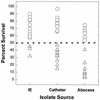In vitro resistance to thrombin-induced platelet microbicidal protein among clinical bacteremic isolates of Staphylococcus aureus correlates with an endovascular infectious source
- PMID: 9835510
- PMCID: PMC106018
- DOI: 10.1128/AAC.42.12.3169
In vitro resistance to thrombin-induced platelet microbicidal protein among clinical bacteremic isolates of Staphylococcus aureus correlates with an endovascular infectious source
Abstract
Platelet microbicidal proteins (PMPs), small cationic peptides released at sites of endovascular damage, kill common bloodstream pathogens in vitro. Our group previously showed that in vitro resistance of clinical staphylococcal and viridans group streptococcal bacteremic strains to PMPs correlated with the diagnosis of infective endocarditis (IE) (Wu et al., Antimicrob. Agents Chemother. 38:729-732, 1994). However, that study was limited by (i) the small number of Staphylococcus aureus isolates from IE patients, (ii) the retrospective nature of the case definitions, and (iii) the diverse geographic sources of strains. The present study evaluated the in vitro PMP susceptibility phenotype of a large number of staphylococcemic isolates (n = 60), collected at a single medical center and categorized by defined and validated clinical criteria. A significantly higher proportion of staphylococcemic strains from patients with IE was PMP resistant in vitro than the proportion of strains from patients with soft tissue sepsis (83% and 33%, respectively; P < 0.01). Moreover, the levels of PMP resistance (mean percent survival of strains after 2-h exposure to PMP in vitro) were significantly higher for isolates from patients with IE and with vascular catheter sepsis than for strains from patients with abscess sepsis (P < 0.005 and P < 0.01, respectively). These data further support the concept that bloodstream pathogens that exhibit innate or acquired PMP resistance have a survival advantage with respect to either the induction or progression of endovascular infections.
Figures

References
-
- Azizi N, Li C, Shen A J, Bayer A S, Yeaman M R. Abstracts of the 36th Interscience Conference on Antimicrobial Agents and Chemotherapy. Washington, D.C: American Society for Microbiology; 1996. Staphylococcus aureus elicits release of platelet microbicidal proteins in vitro, abstr. G54; p. 153.
-
- Cheng D, Bayer A S, Yeaman M R, Corey G R, McClelland R S, Harrell E, Fowler V G. Abstracts of the 38th Interscience Conference on Antimicrobial Agents and Chemotherapy. Washington, D.C: American Society for Microbiology; 1998. In vitro resistance to thrombin-induced platelet microbicidal protein (tPMP) among Staphylococcus aureus bacteremic (SAB) isolates correlates with endovascular infection source, abstr. B-20; p. 50. - PubMed
Publication types
MeSH terms
Substances
Grants and funding
LinkOut - more resources
Full Text Sources
Other Literature Sources
Medical

